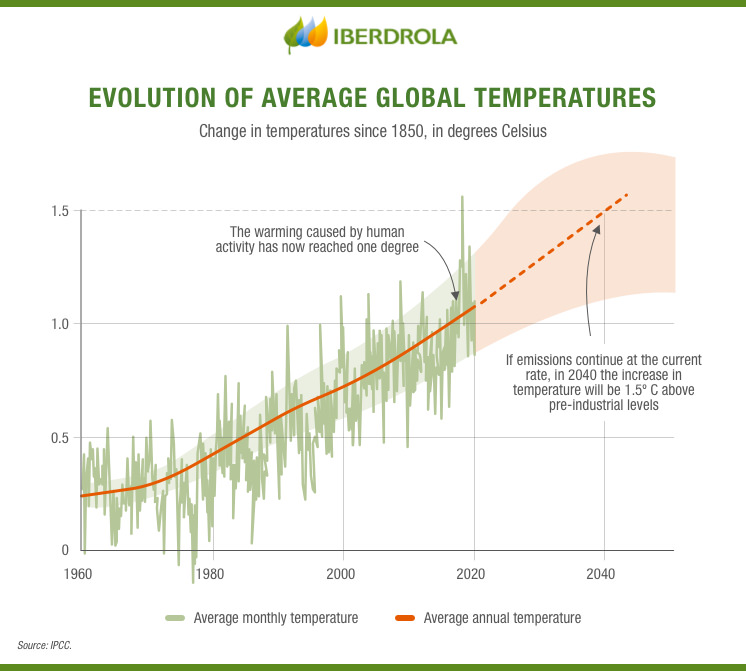Average temperature of the earth
Temperatures continue to rise with the turn of the decade
2022 again closed with one of the highest temperatures in history since records began in 1880. This is coupled with the fact that of the 10 warmest years in history, 9 have occurred in the last 9 years. The consequences of the increase in the Earth's average temperature range from rising oceans to the proliferation of extreme weather events.

These are bad times for the planet's climate. The exponential increase in CO2 emissions, the result of human activity, has pushed the earth's thermometer since the end of the 19th century beyond the limits of the imaginable. Today we are moving dangerously close to the 2ºC threshold and, if we cross it, we will face the irreversible effects of a climate crisis without precedent in history.
Climate report data
Between 2010 and 2019 it has been warmer than ever before and this is no exaggerated weather observation. If the latest state of the climate report from the World Meteorological Organisation (WMO) is anything to go by, we have just completed the warmest decade since records began (1850). Never before has a decade been marked by such an extraordinary rise in the Earth's average temperature, which, in 2019 was around 1.1 ºC above pre-industrial levels.
2019 will be remembered as one of the three hottest years in history — the warmest remains 2016 — and a particulary sad chapter in polar melting, with the second worst summer of the century in the Arctic. Other regions of the planet such as Asia, South America, Africa, Europe and Oceania also experienced an increase in average temperatures, which have been climbing and surpassing decade after decade since 1980.
Subsquent years have not helped temperatures to decline. 2022 was the sixth warmest year on record, tied with 2015, while previous years were also extremely hot. Europe and Asia reached their warmest temperature in the last three years (2020) and also the second warmest (2022) according to the National Centers for Environmental Information External link, opens in new window.
External link, opens in new window.
Climate summary 2022
The US National Oceanic and Atmospheric Administration (NOAA) has complied a list of the main global weather events for 2022. Here are some of the most relevant ones:
North America
Alaska had record high temperature record and several rivers basins — such as the Missouri and Mississippi — were affected by flooding between March and July.
Central and South America
Mexico experienced the hottest August in its history and South America the second warmest year since 1909. The region also experienced hurricanes and tropical storms such as Iba.
Europe
The Old Continent was ravaged by several heat waves, resulting in multiple fires and what was the second hottest year in the continent's history.
Asia
This continent experienced the second warmest year of the last century, with the biggest June heatwave in Japan's history. China and Pakistan also suffered the worst floods in years, while the east of the continent was hit by two typhoons, which made landfall in South Korea and the Phillipines, Vietnam and Laos respectively.
Africa
Madagascar was the worst performer in Africa, with two cyclones and a tropical storm in just one month. February, for the first time since 1988. South Africa also broke its record for rainfall in the east of the country during April.
Oceania
Australia experienced extreme rainfall and flooding in the east of the country during the last days of February and the first days of March,
Causes and consequences of the increase in the planet's temperature
The rise in the Earth´s average temperature in recent years— driven by the high concentration of greenhouse gases in the atmosphere— has had serious consequences for the planet. These are the most worrying:
Ocean flooding and melting of poles and glaciers
Sea levels rose by 0.27 cm over the past year, an increase of 9.1 centimetres since 1993. In addition to the meltic Arctic ice, Antarctic ice melt has reached its second lowest point, with only 3.36 million square miles of ice, 660,000 miles less than the 1991-2020 average.
Ocean warming and acidification
Ocean temperatures broke records, with 2022 being the sixth warmest year ever. This warming has increased ocean acidification by 26% compared to 1750, contributing to the destruction of marine ecosystems.
Extreme weather events
Over the past year, climate catastrophes have increased exponentially, with fires and heat waves sweeping across Europe and Asia while floods have severely affected areas such as Pakistan and South Africa, forcing the million displacement of thousands of people.
Damage to health and food safety
In 2022, unprecedented heat waves were recorded in Japan, South America and Europe, and a large increase in cholera and yellow fever cases compared to 2021. On the other hand, food security in parts of Africa and Asia has been compromised by droughts and floods.

 SEE INFOGRAPHIC: The evolution of average global temperature [PDF] External link, opens in new window.
SEE INFOGRAPHIC: The evolution of average global temperature [PDF] External link, opens in new window.
Solutions to the increase in the average temperature of the earth
The Paris Agreement about climate change in 2015 enshrined the international community's commitment — within the United Nations Framework Convention on Climate Change (UNFCCC) — to keep average global temperature increase to below 2 ºC compared to pre-industrial levels. The following measures would help to slow global warming:
- Gradually reducing CO2 emissions: to 45% during the first decade and to zero after 2050.
- Slowing the deforestation, endangering the planet's ecosystems and minimising the use of fossil fuels.
- Moving towards a clean, more efficient energy model, based on the use of renewable sources.
- Encouraging responsible consumption and reduction, reuse and recycling the fundamental 3Rs of the circular economy—.
- Adopting a more sustainable diet — rich in fruit and vegetables — and reducing food waste.




